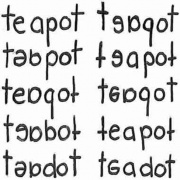Introduction to Psychology 1/IPSY102/Intelligence/Learning disabilities
Learning disabilities are cognitive disorders that affect different areas of cognition, particularly language or reading. It should be pointed out that learning disabilities are not the same thing as intellectual disabilities. Learning disabilities are considered specific neurological impairments rather than global intellectual or developmental disabilities. A person with a language disability has difficulty understanding or using spoken language, whereas someone with a reading disability, such as dyslexia, has difficulty processing what he or she is reading.
Often, learning disabilities are not recognized until a child reaches school age. One confounding aspect of learning disabilities is that they often affect children with average to above-average intelligence. At the same time, learning disabilities tend to exhibit comorbidity with other disorders, like attention-deficit hyperactivity disorder (ADHD). Anywhere between 30–70% of individuals with diagnosed cases of ADHD also have some sort of learning disability (Riccio, Gonzales, & Hynd, 1994[1]). Let’s take a look at two examples of common learning disabilities: dysgraphia and dyslexia.
Dysgraphia
Children with dysgraphia have a learning disability that results in a struggle to write legibly. The physical task of writing with a pen and paper is extremely challenging for the person. These children often have extreme difficulty putting their thoughts down on paper (Smits-Engelsman & Van Galen, 1997[2]). This difficulty is inconsistent with a person’s IQ. That is, based on the child’s IQ and/or abilities in other areas, a child with dysgraphia should be able to write, but can’t. Children with dysgraphia may also have problems with spatial abilities.
Students with dysgraphia need academic accommodations to help them succeed in school. These accommodations can provide students with alternative assessment opportunities to demonstrate what they know (Barton, 2003[3]). For example, a student with dysgraphia might be permitted to take an oral exam rather than a traditional paper-and-pencil test. Treatment is usually provided by an occupational therapist, although there is some question as to how effective such treatment is (Zwicker, 2005[4]).
Dyslexia
Dyslexia is the most common learning disability in children. An individual with dyslexia exhibits an inability to correctly process letters. The neurological mechanism for sound processing does not work properly in someone with dyslexia. As a result, dyslexic children may not understand sound-letter correspondence. A child with dyslexia may mix up letters within words and sentences—letter reversals are a hallmark of this learning disability—or skip whole words while reading. A dyslexic child may have difficulty spelling words correctly while writing. Because of the disordered way that the brain processes letters and sound, learning to read is a frustrating experience. Some dyslexic individuals cope by memorizing the shapes of most words, but they never actually learn to read (Berninger, 2008[5]).
References
- ↑ Riccio, C. A., Gonzales, J. J., & Hynd, G. W. (1994). Attention-deficit Hyperactivity Disorder (ADHD) and learning disabilities. Learning Disability Quarterly, 17, 311–322.
- ↑ Smits-Engelsman, B. C. M., & Van Galen, G. P. (1997). Dysgraphia in children: Lasting psychomotor deficiency or transient developmental delay? Journal of Experimental Child Psychology, 67, 164–184.
- ↑ Barton, S. M. (2003). Classroom accommodations for students with dyslexia. Learning Disabilities Journal, 13, 10–14.
- ↑ Zwicker, J. G. (2005). Effectiveness of occupational therapy in remediating handwriting difficulties in primary students: Cognitive versus multisensory interventions. Unpublished master’s thesis, University of Victoria, Victoria, British Columbia, Canada). Retrieved from http://dspace.library.uvic.ca:8080/bitstream/handle/1828/49/Zwicker%20thesis.pdf?sequence=1 i Downloads History Attribution More Information
- ↑ Berninger, V. W. (2008). Defining and differentiating dysgraphia, dyslexia, and language learning disability within a working memory model. In M. Mody & E. R. Silliman (Eds.), Brain, behavior, and learning in language and reading disorders (pp. 103–134). New York: The Guilford Press.
- Source
- This page was proudly adapted from Psychology published by OpenStax CNX. Oct 31, 2016 under a Creative Commons Attribution 4.0 license. Download for free at http://cnx.org/contents/4abf04bf-93a0-45c3-9cbc-2cefd46e68cc@5.52.
